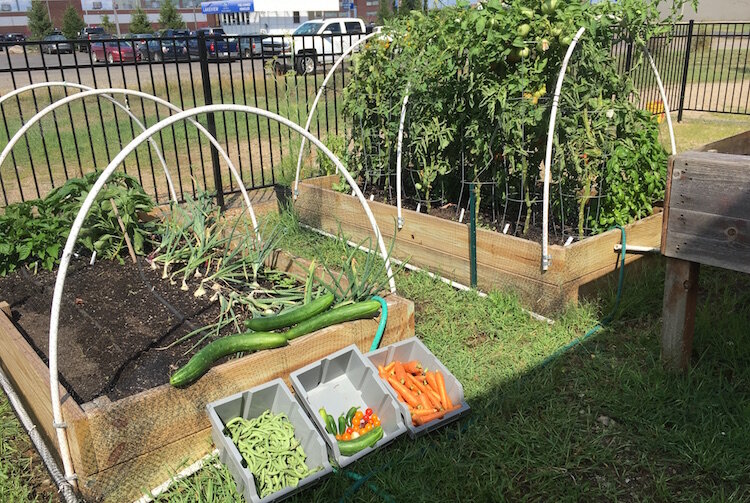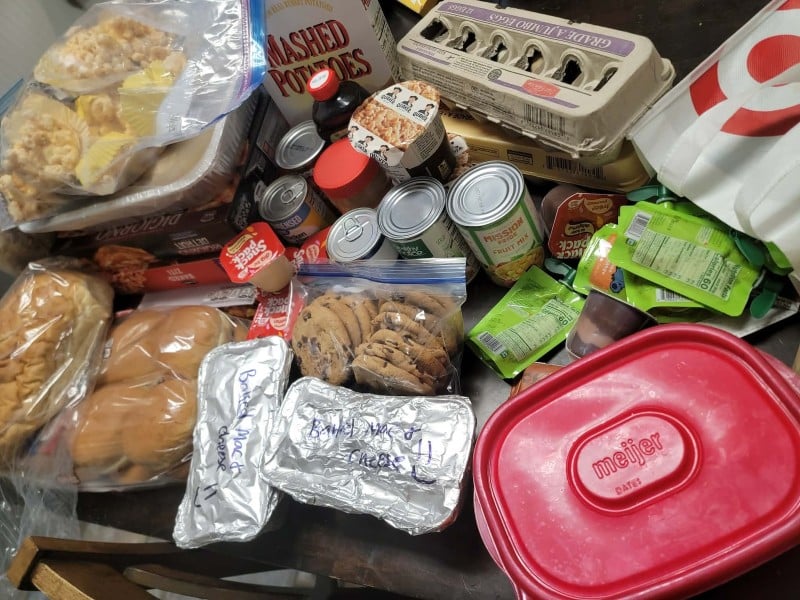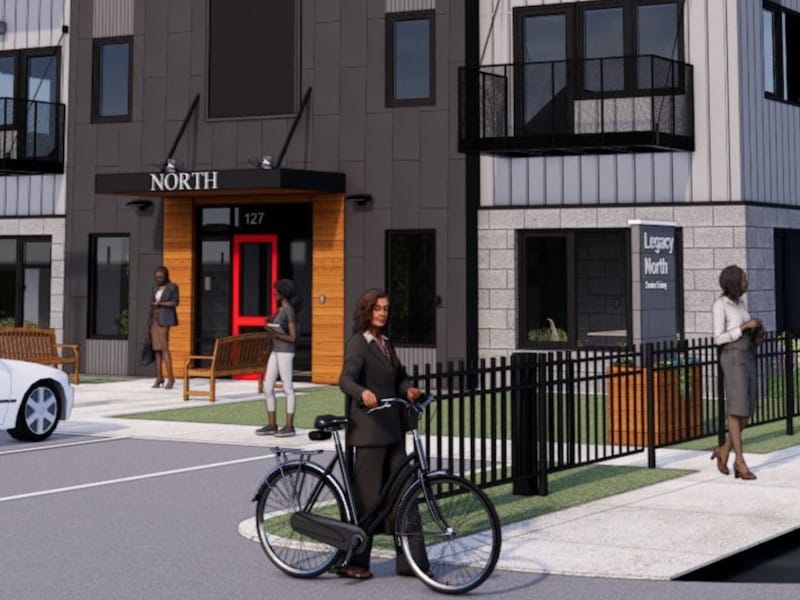Gardners grow self-esteem, community alongside veggies at SHARE’s Garden of Eatin’ in Battle Creek
Not only does its produce feed those who come to the SHARE Center, the garden also has been designed as a “pick and eat.” Many plants grow around the perimeter of the garden so that anyone who is hungry can simply lean over and pick something to eat.
Editor’s note: This story is part of Southwest Michigan Second Wave’s On the Ground Battle Creek series.
A garden tucked away on Grove Street is growing purpose and self-esteem, in addition to vegetables.
Christened the “Garden of Eatin’”, the garden is located on property owned by the SHARE (Self-Help Awareness Recovery and Enrichment) Center and is tended by consumers and staff with the organization, says Robert Elchert, SHARE Center executive director.
Members of the organization’s Women’s Group, one of many programs and services offered, have told Elchert that they find it therapeutic to get their hands in the dirt.

“They are learning how to plant and they have the additional responsibility of taking care of the plants. They appreciate being given the opportunity to care for something and feel a sense of pride when they plant a seed and watch it grow into a fruit or vegetable,” Elchert says.
For many of the consumers – men and women – the garden presents tangible evidence of their work.
The SHARE Center annually serves more than 5,500 individuals, 250 of them Veterans, by providing a mutually supportive, safe space with resources for the recovery of vulnerable people who are experiencing issues with homelessness, mental health, hunger, or addiction.
Programs and services include a Drop-In Resource Center that offers support groups, information, and resources for those dealing with mental health or addiction issues; assistance with securing state identification and vital records information; free transportation; and enrichment activities like art classes, a computer lab, and the garden.
“Some of our consumers didn’t have the educational opportunities that many of us had growing up. They think that carrots come from a grocery store because they never had exposure to a garden and what is grown there,” Elchert says. “This garden makes an almost holistic impact on the people who work it.”
The majority of what’s grown in the garden finds its way into the free breakfasts, lunches, and dinners served each day at the SHARE Center. Annually more than 30,000 meals are prepared and served for individuals and families, Elchert says.
Those consumers who have housing may grow their own plants and take them home to use in meals they prepare in a shared kitchen, says Kathy Antaya, a longtime community volunteer who serves as a resource and works alongside those who tend the garden.

“A lot of people in the Women’s Group share living space with others and have access to a kitchen so it’s nice when they can go back with an armload of vegetables to use,” Antaya says. “We’re trying to avoid a charity feeling at the garden.”
This goes back to the unconditional giving and non-judgmental atmosphere that is woven through every aspect of the SHARE Center. Antaya says she remembers being there at dinnertime and being offered a meal. She told the staff person that she didn’t qualify because she is not considered low-income.
“That person asked if I was hungry, which I was, and they said please eat, which I did,” Antaya says.
But, access to the fruits and vegetables grown is not limited to SHARE Center consumers. Antaya says the garden has been designed as a “pick and eat” with many plants grown around the perimeter of the garden’s fence so that anyone who is hungry can simply lean over and pick a tomato, pepper, or anything else that is ready to eat.
“People like to contribute to a goal and belong to a bigger purpose. If you can help mow or weed, all of these contribute to the overall goal of the garden. But, if you don’t pull a weed, we’re not going to turn you away,” she says. “I don’t care who you are. If you’re hungry come in and get something.”
An Idea Takes Root
Shortly after Elchert joined the SHARE Center in 2019, he began having conversations with consumers about what they wanted, and “a garden just kept coming up.”
Around that time, he also met Antaya, a retired Golf Course Management professional, who Elchert says is the “best thing that happened to the garden. She not only said ‘yes’ she went to town with it and we got her connected with the Women’s Group in maintaining the garden.”
Various groups in the community provided free supplies and labor to turn a more than 500-square-foot space into a garden. Senior Services Tuesday Toolmen group built three raised beds, CityLinc installed fencing provided by Lowe’s at a nominal charge, and the city of Battle Creek donated 20 yards of compost soil.
Currently, there are five beds of plants and numerous containers that produce a wide variety of vegetables throughout the year, including peas, kale, squash, cucumbers, and collard greens.
“It’s always fun to put a meal or salad out and say this was grown in our garden,” Elchert says. “It’s really great that we can offer some healthier alternatives. If things go well maybe we can grow it into an entrepreneurial program and use it for raising money for the SHARE Center.”
At some point, Elchert says he would like to grow the garden program and give consumers an opportunity to be entrepreneurs by selling what they grow at farm stands. He says it’s a goal that could happen depending on increases in what is grown and harvested.
“Last year we grew more tomatoes than we knew what to do with,” Elchert says.
SHARE consumers are a big part of decisions made about what gets planted. Planting is a topic of conversation at a regular Monday meeting where they learn what’s going on at the garden.
“I am impressed with the garden and the way that it’s giving our consumers something meaningful to do,” Elchert says. “I always have people asking if they could volunteer for things like cleanup and landscaping.”
Is gardening therapeutic?
Although the SHARE Center’s garden is not in an unconventional space and is not designated as a therapeutic garden, there are gardens that began years ago in prison yards, retirement and veteran homes, and programs for troubled youth that are considered therapeutic gardens, according to the American Horticulture Therapy Association.
“In recent years we have seen a significant upswing of interest in therapeutic gardens. These gardens are specifically designed to address a variety of applications within healthcare, rehabilitative, and other therapeutic settings,” says an article on the AHTA’s website.
Most are handy sources of fresh and local food, but increasingly they’ve become an extension of therapy for people with mental health issues, such as post-traumatic stress disorder, or PTSD; depression; and anxiety, issues that some SHARE Center consumers experience. Gardening is called horticultural therapy and some doctors, psychologists, and occupational therapists are testing whether building, planting, and harvesting a garden can be a therapeutic process in its own right, according to the Journal of Therapeutic Horticulture.
Much of the science behind just how gardening affects the mind and brain still remains a mystery. What scientists do know is that gardening reduces stress and calms the nerves. It decreases cortisol, a hormone that plays a role in stress response, according to researchers with the AHTA
A 2011 study at a juvenile rehabilitation center in southwestern Ohio with a gardening program showed that horticulture therapy helped the kids see themselves in a more positive light and helped them better manage their emotional and behavioral problems. And most of the kids said they would continue gardening after the program, according to the findings in the Journal of Therapeutic Horticulture.
One 2007 study in the journal Neuroscience found a bacteria found in soil linked with increased serotonin production in the brain — a sign that gardening could increase serotonin levels and improve depression.
“Social scientists have also been looking at gardens built by and for the homeless, ex-convicts on probation, and hospital patients. The results of early studies suggest they have a positive impact. Most people tend to not revert back to bad behavior and many make changes in their lives for the better, the studies show,” says an article in the Journal of Therapeutic Horticulture.
Antaya says those who volunteer to work in the garden have told her that they enjoy the consistency of watching something evolve over time and it gives them something to look forward to.
“There’s some surety and that is helpful,” she says.
When Antaya retired after a 35-year career in golf course management, she says she never thought she’d find anything as rewarding as that work. And then she discovered urban and community gardening, which she has been involved in since 2010. She calls this work a “game-changer” because of the many opportunities it provides, such as creating easy access to healthy food and teaching math skills by having people count the number of plants they are planting.
There also is a less tangible benefit that puts everyone working these gardens on equal footing, Antaya says.
“It works as a community-building tool. You may not have anything in common except planting vegetables or flowers, but that brings you together,” she says. “In the garden, we are all equal. Sometimes marginalized or homeless folks don’t feel like full citizens, but when you’re working in a garden, we’re all equal and we can all contribute. Being a part of something beneficial that’s bigger than themselves is huge and I think folks who are down on their luck and are always receiving help from other people feel super good being able to turn around and return the favor by growing food and sharing it.”
















